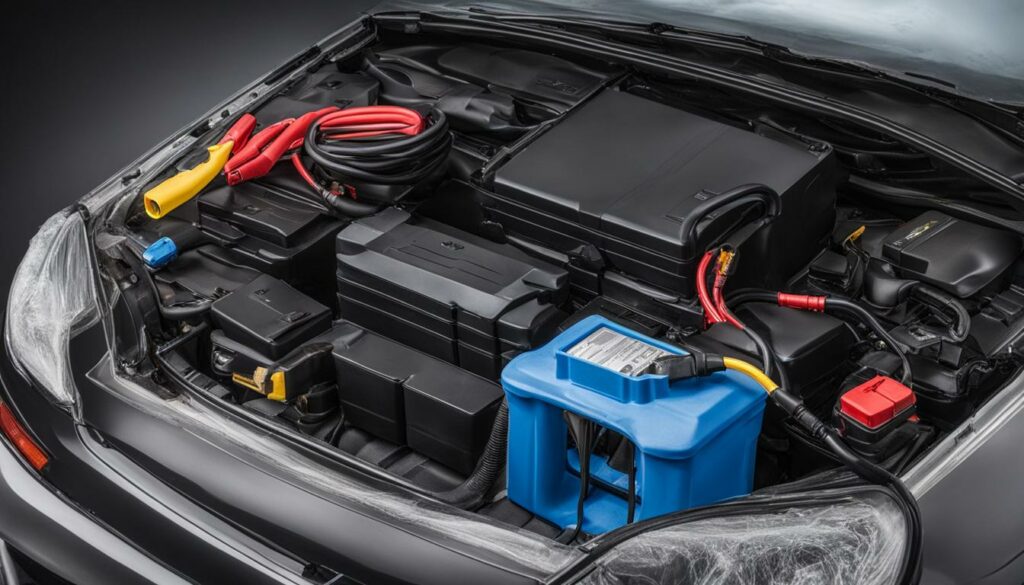It’s a common concern for car owners – can a car battery get wet? The answer is yes, it can. However, exposure to water can cause serious damage to your car’s electrical system and even pose safety hazards. That’s why it’s essential to understand the risks involved and take precautions to prevent water damage to your car battery.
In this section, we’ll discuss the vulnerability of car batteries to water damage and the hazards that a wet battery can pose. We’ll also provide tips for identifying water damage in your car battery and preventing further damage. Finally, we’ll guide you through the steps to deal with a water-damaged battery and provide safety considerations for handling a wet battery.
Key Takeaways:
- Car batteries can get wet and sustain water damage.
- Water damage can cause serious harm to your car’s electrical system and safety hazards.
- It’s crucial to identify signs of water damage and take precautions to prevent further damage to your car battery.
- If your car battery has already been exposed to water, addressing the issue promptly and safely is crucial.
- Proper safety measures should be followed when handling a wet car battery.
Understanding Car Batteries and Their Vulnerability
Car batteries are a critical component of your vehicle’s electrical system. They provide the power necessary to start your engine and keep it running smoothly. However, car batteries are vulnerable to various types of damage, including water damage and corrosion.
When a car battery is exposed to water, it can cause significant damage to the battery’s internal components. Water can corrode the battery terminals and other metal parts, leading to a loss of conductivity and a decrease in the battery’s overall performance.
Corrosion is another common issue that affects car batteries. When metal components within the battery corrode, it can lead to a buildup of sulfuric acid on the battery’s surface. This acid can cause further corrosion and damage to the battery, leading to reduced performance and potentially even battery failure over time.
Understanding Car Batteries and Their Vulnerability
There are several factors that can make car batteries vulnerable to water damage and corrosion. These include:
- Age: As car batteries age, they become more susceptible to damage from water and other harmful elements.
- Exposure to Moisture: Car batteries that are exposed to high levels of moisture or dampness are more likely to sustain water damage and corrosion.
- High Temperatures: Exposure to high temperatures can cause a car battery to overheat, leading to damage and reduced performance.
- Improper Maintenance: Failure to maintain your car battery properly can make it more vulnerable to damage from water and corrosion.
To prevent water damage and corrosion, it’s essential to understand how to properly care for and maintain your car battery. By keeping your battery clean and dry, regularly checking its voltage, and addressing any signs of damage promptly, you can help ensure your battery remains in excellent condition for years to come.
Remember, prevention is always better than cure when it comes to car batteries. By taking proactive steps to protect your battery from water damage and corrosion, you can help avoid costly repairs and replacements down the line.
The Hazards of a Wet Car Battery
If you think a little bit of water won’t hurt your car’s battery, think again. Exposure to moisture can have severe consequences for your battery and your vehicle’s electrical system.
When water seeps into your car battery, it can cause corrosion on the terminals, resulting in poor electrical connections. This can lead to voltage drops and prevent your car from starting or cause electrical issues while driving.
Furthermore, a wet battery increases the risk of electrical shock and fire hazards. Water conducts electricity, so if you come into contact with a water-damaged battery, you could be putting yourself in danger.
Risks of Not Addressing Water Damage
If left unaddressed, water damage in your car battery can lead to bigger problems, such as a complete battery failure or damage to your vehicle’s electrical system, which could be costly to repair.
Additionally, the longer you wait to address the issue, the more damage the water can cause. So, it’s crucial to take the necessary steps to protect your battery and address any water damage as soon as possible.
Table: Hazards of a Wet Car Battery
| Risks | Hazards |
|---|---|
| Corrosion on the battery terminals | Poor electrical connections leading to voltage drops and electrical issues |
| Increased risk of electrical shock | Water conducts electricity, increasing the likelihood of electric shock |
| Fire hazards | Water can cause short circuits, leading to fire hazards |
As you can see, there are many hazards associated with a wet car battery. So, it’s important to take the necessary precautions to prevent water damage and address any issues promptly to avoid further damage and potential safety risks.

By following these simple maintenance tips and precautions, you can help prevent water damage to your car battery, ensuring that it performs optimally for years to come.
Dealing with a Water-Damaged Car Battery
If your car battery has been exposed to water, it’s essential to take immediate action to prevent further damage. Here are the steps to follow:
- Disconnect the battery: Before you do anything, make sure you switch off the engine and disconnect the battery cables. This will help prevent any electrical shorts or shocks while you’re working on the battery.
- Remove the battery from the vehicle: Take the battery out of your car and place it on a dry surface, away from any sources of water or moisture.
- Clean the battery: Use a soft-bristle brush and a solution of baking soda and water to clean the battery terminals, posts, and cables. This will help remove any corrosion or residue caused by the water damage. Rinse the battery with clean water afterward.
- Inspect the battery: Carefully examine the battery for any signs of damage, such as cracks or leaks. If the battery is damaged, it’s best to replace it to avoid any further issues.
- Charge the battery: If the battery isn’t damaged, you can try to charge it. Use a battery charger to recharge the battery fully. However, if it doesn’t hold a charge, it’s time for a replacement.
- Reinstall the battery: Once you’ve cleaned and charged the battery, put it back in your car, and reconnect the battery cables. Make sure the connections are tight and secure.
If your battery has sustained significant damage, it may be time for a replacement. Look for a high-quality replacement battery that’s compatible with your vehicle. You can consult with a certified mechanic to help make this decision.
Safety Considerations When Handling a Wet Car Battery
Dealing with a wet car battery requires caution and safety measures to avoid hazards and injuries. Keep in mind that water and electricity don’t mix, so it’s essential to take precautions when handling a wet battery to prevent electrical shock or other accidents. Here are some safety considerations to keep in mind:
- Wear protective clothing and gear: Always wear gloves and protective clothing such as a face shield to prevent skin contact with any hazardous materials that may have come into contact with the battery.
- Turn off the engine and disconnect the battery: Before handling the battery, turn off the engine, and disconnect the battery’s cables to prevent further electrical discharge or accidental start-up.
- Avoid touching the battery terminals: Even if the battery is wet, avoid touching its terminals with your bare hands as it can cause electrical shock or burns.
- Clean the battery: If you need to clean the battery, use a solution of baking soda and water to neutralize any acid in the battery before cleaning it with a soft brush or cloth. Then rinse it off with water and dry it thoroughly.
- Dispose of the battery safely: If your battery is damaged, corroded, or beyond repair, dispose of it appropriately, taking care not to damage the environment. You can contact a professional waste disposal service to recycle your battery.
Following these safety considerations can help you deal with a wet car battery safely and prevent any potential hazards to yourself or others. If you are unsure about how to handle your wet battery, consult a professional mechanic for assistance.
Protecting Your Car Battery in Wet Conditions
Driving in wet conditions or leaving your car parked in a damp environment can increase the risk of water damage to your car battery. Fortunately, there are some easy steps you can take to prevent damage and prolong the life of your battery.
Keep Your Battery Clean and Dry
Regularly cleaning and drying your car battery can help prevent corrosion and water damage. Use a rag or old towel to wipe off any dirt or debris, and make sure to keep the battery terminals clean and dry. If you notice any signs of corrosion, use a battery cleaning solution and a wire brush to remove it.
Invest in a Battery Cover
A battery cover is a simple and effective way to protect your car battery from moisture and debris. It fits easily over the battery and helps keep it dry and clean. You can find battery covers at most auto parts stores or online.
Park in a Covered Area
Parking your car in a covered area, such as a garage or carport, can help protect your battery from moisture and other environmental hazards. If you don’t have access to a covered area, consider investing in a car cover to provide additional protection.
Check Your Battery Regularly
Regular battery checks can help prevent water damage and other issues. Inspect your battery regularly for signs of corrosion or damage, and make sure the connections are tight and secure. If you notice any issues, address them promptly to prevent further damage.
Consider a Maintenance-Free Battery
Maintenance-free batteries are designed to require little to no maintenance, making them an excellent choice for those who want to avoid the hassle of regular battery checks. These batteries are sealed and contain no liquid, making them less susceptible to water damage and other issues.
By following these tips, you can help protect your car battery from water damage, corrosion, and other hazards, ensuring that it performs optimally for years to come.
Conclusion
As a car owner, it’s important to understand the potential hazards and risks associated with a wet car battery. By following proper maintenance practices, you can prevent water damage and ensure your battery performs optimally.
Regular maintenance, such as checking for signs of corrosion, can help you identify and address any issues before they become severe. If your car battery has already sustained water damage, it may be time to consider a replacement.
Remember, safety should always be a top priority when handling a wet car battery. Ensure you are following the proper precautions to avoid any potential hazards.
By taking proactive measures to protect your car battery from moisture and water damage, you can extend the life of your battery and avoid costly replacements. Keep your car running smoothly by prioritizing proper maintenance for your car battery today.


